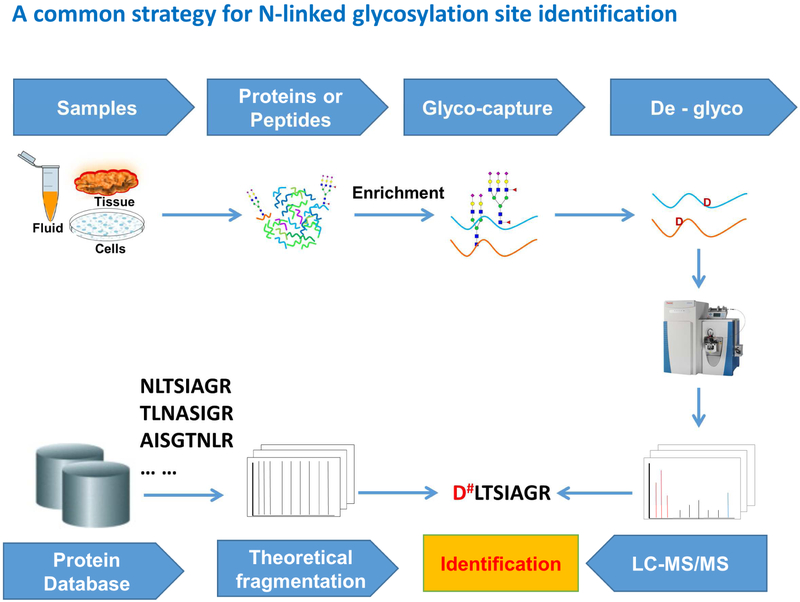N- and O-Linked Glycosylation Mapping Service
N- and O-linked glycosylation mapping is a critical structural analysis method used to systematically identify glycan attachment sites and their structural types on proteins, helping to reveal regulatory relationships between glycans and proteins. N-glycosylation typically occurs at asparagine residues within the consensus sequence N-X-S/T (X ≠ P), whereas O-glycosylation usually targets serine (Ser) or threonine (Thr) residues and is characterized by higher structural diversity and a lack of conserved sequence motifs. By identifying N- and O-glycan attachment sites and their occupancy patterns, researchers can gain deeper insight into how glycosylation influences protein folding, stability, functional regulation, and disease progression.
MtoZ Biolabs offers N- and O-linked Glycosylation Mapping Service using multi-dimensional enrichment strategies and high-resolution mass spectrometry platforms, supporting high-quality data generation for studies in glycobiology, drug development, and biomarker research.
Technical Principles
Our N- and O-linked Glycosylation Mapping Service utilizes high-resolution mass spectrometers including the Thermo Fisher Q Exactive HF and Orbitrap Fusion Lumos, in combination with Nano-LC systems, to achieve high-sensitivity glycopeptide detection and structural analysis. The workflow integrates the following components:
· Lectin Affinity Enrichment: Specific glycopeptide capture using lectin recognition of glycan structures to selectively enrich targets from complex backgrounds.
· Glycosidase Digestion: Site localization is supported by enzymatic cleavage of glycans using PNGase F (for N-glycans) and O-glycosidase (for O-glycans).
· Chemical Labeling Strategies: Stable isotope and isobaric labeling approaches such as SILAC and TMT enhance the ability to compare glycosylation changes across different conditions.
· Advanced Fragmentation Techniques: Fragmentation methods such as EThcD improve spectral resolution and enable precise localization of O-glycosylation sites.
Services at MtoZ Biolabs
· N- and O-Glycosylation Site Analysis
Identification of specific N- and O-linked glycosylation sites on proteins using LC-MS/MS combined with selective glycopeptide enrichment, resulting in detailed glycosylation site maps.
· N- and O-Glycosylation Site Occupancy Analysis
Quantitative assessment of glycosylation occupancy at each site based on site identification, using label-free or labeling-based strategies to uncover regulatory differences, suitable for dynamic modification studies.
· N- and O-Glycan Linkage Analysis
Determination of monosaccharide linkage types (e.g., 1→3, 1→6) within glycans to characterize spatial conformations and branching patterns, complementing site-level information with structural insights.

Dang, L. et al. Trends Analyt Chem. 2019.
Figure 1. Workflow for N-linked Glycoprotein and Glycosylation Site Identification
Why Choose MtoZ Biolabs?
✔ Advanced Analytical Platforms: Orbitrap-based high-resolution mass spectrometry combined with Nano-LC systems ensures excellent sensitivity and accuracy.
✔ Diverse Glycopeptide Enrichment Strategies: Integration of lectin affinity, HILIC, and enzymatic methods increases detection efficiency for low-abundance modifications.
✔ Multi-Dimensional Structural Analysis: Use of CID, HCD, and ETD fragmentation techniques, along with enzymatic validation, supports the interpretation of glycan structure, linkage type, and heterogeneity, generating rich data for glycosylation mapping.
✔ Flexible Quantification Spproaches: Supports both label-free and labeling-based quantification methods (e.g., TMT, iTRAQ) to assess glycosylation dynamics under varying conditions.
✔ Broad Sample Compatibility: Applicable to a wide range of biological samples including native and recombinant proteins, serum, tissue homogenates, and cell lysates.
Sample Submission Suggestions
Clients are advised to prepare samples with high purity and adequate glycoprotein content, according to the research objective. Acceptable sample types include purified proteins, cell lysates, tissue homogenates, and serum or plasma.
To ensure optimal analysis quality, samples should be free from high salt concentrations, surfactants, and reducing agents. Cold storage is recommended, and samples should be transported under refrigerated conditions. MtoZ Biolabs provides comprehensive sample preparation and submission guidelines, and technical consultation is available before project initiation to help optimize experimental design.
N- and O-linked glycosylation mapping enables comprehensive insight into the spatial distribution and functional significance of glycosylation modifications. It is a powerful tool for understanding protein structural modifications, identifying biomarkers, and optimizing biopharmaceuticals. With advanced mass spectrometry platforms, a professional team, and extensive project experience, MtoZ Biolabs offers reliable, flexible, and customizable N- and O-Linked Glycosylation Mapping Service to support your research and development needs.
For more information or to request a sample submission guide, please contact our technical team.
What Could be Included in the Report?
1. List of identified glycosylation sites including positions, types, and confidence scores
2. Site-specific glycosylation occupancy data with between-group comparisons
3. Structural annotation of glycan linkage types
4. Visualized report including glycan maps, heatmaps, and network diagrams
5. Raw mass spectrometry data and method documentation
FAQ
Q1: What are the advantages of glycosylation mapping compared to single-site glycosylation analysis?
N- and O-linked glycosylation mapping provides more than just site identification. It integrates occupancy data, glycan linkage information, and structural annotations to generate a systematic and visual representation of glycosylation. Compared to isolated site analysis, this approach delivers a comprehensive perspective that facilitates functional interpretation and cross-sample comparison, especially in large-scale studies or mechanism-driven research.
Related Services
N- and O-Glycosylation Site Occupation Analysis Services
How to order?







